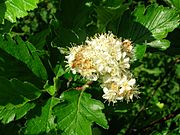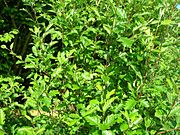Arran whitebeams facts for kids
The Arran whitebeams are special trees. They are a type of whitebeam tree found only on the Isle of Arran in Scotland. These trees are unique to Arran, meaning they don't naturally grow anywhere else in the world.
Contents
Rare Trees of Arran
The Arran whitebeams are some of the rarest trees on Earth. There are three main types:
- The Scottish whitebeam (Sorbus arranensis)
- The cut-leaved whitebeam (Sorbus pseudofennica)
- The Catacol whitebeam (Sorbus pseudomeinichii)
In 1980, only 283 Scottish whitebeams and 236 cut-leaved whitebeams were counted. This shows how rare they are.
Protecting Arran's Whitebeams
These trees are protected in an area called Glen Diomhan. This area is part of a special nature site. Sadly, animals grazing and insects eating the young trees stop new ones from growing.
The trees usually grow on mountain slopes. But they can also grow at lower places. Some are growing in Brodick Country Park. Local park staff are also growing them to help save the species. A few special plant nurseries can supply these trees. Ardrossan Academy even has one for students to study evolution.
Where Do Arran Whitebeams Grow?
Here's where you can find these rare trees on Arran:
- Scottish whitebeam (Sorbus arranensis): Abhainn Bheag, Glen Diomhan, Glen Catacol, Allt nan Calman, Allt Dubh, Gleann Easan Biorach, and Glen Iorsa.
- Cut-leaved whitebeam (Sorbus pseudofennica): Abhainn Bheag, Glen Diomhan, and Allt nan Calma.
- Catacol whitebeam (Sorbus pseudomeinichii): Glen Catacol.
A Look Back: History of the Arran Whitebeams
The oldest known sample of the cut-leaved whitebeam (S. pseudofennica) was collected in 1797. Another sample from 1838 is in the British Museum. Back then, it was known by a different name. In 1952, scientists officially recognized S. pseudofennica as its own species.
The Scottish whitebeam (S. arranensis) became very popular with plant collectors in the late 1800s and early 1900s.
How Arran Whitebeams Evolved
The Arran whitebeams have a fascinating family tree. It all started with the common whitebeam (Sorbus aria). This tree gave rise to the rock whitebeam (Sorbus rupicola). The rock whitebeam can grow in harsh, high-up places. You can still find it on Holy Isle.
The rock whitebeam then mixed with the rowan or mountain ash (Sorbus aucuparia). This created a new, fertile species: the Scottish whitebeam (Sorbus arranensis). This new tree also grows well in high places.
Later, the Scottish whitebeam (S. arranensis) mixed again with the mountain ash (S. aucuparia). This led to the bastard mountain ash (Sorbus pseudofennica).
Special Way of Making Seeds
The Sorbus group of trees, including the Arran whitebeams, can make seeds without needing pollen from another tree. This is called apomixis. It means each time these hybrid trees are formed, they create a new, identical copy of themselves.
Scientists have studied these trees closely. They found that these species are truly separate. They are not just random variations.
Other Rare Whitebeams
Many other rare Sorbus species have evolved in a similar way. Examples include the Devon whitebeam and the Bristol whitebeam. All these trees are rare. They need careful protection to survive in the wild.
Interestingly, similar trees have also evolved in places like Norway. This happened because of similar natural pressures, but completely separately from the Arran whitebeams.
Islands are often home to unique species. The Lundy cabbage is another British example. It only grows on Lundy Island off the North Devon coast.
What Do They Look Like?
The mountain ash has leaves made of many small leaflets. The common whitebeam has a single, whole leaf. When these two types of trees mix, their hybrid offspring show a blend of features.
- S. arranensis has leaves with lobes (like rounded sections) but no separate leaflets.
- S. pseudofennica has had an extra mix with the mountain ash. So, its leaves have both lobes and some true leaflets.
Sometimes, it can be hard to tell the species apart for sure. This might be because they can still mix with each other. There are also small differences in their flowers and seeds.
Unlike some other rare British plants, these trees don't seem to prefer soils rich in certain minerals.
What's Next for the Arran Whitebeams?
The number of Arran whitebeams hasn't dropped much since the first count in 1897. But this might be misleading. More trees have been found simply because people have looked harder. This doesn't mean the population is stable. Efforts to plant young trees grown from native seeds have had mixed results.
Sheep grazing has likely reduced the number of trees. It has pushed them to grow only on steep slopes and in rock cracks. This is why they are mostly found in the mountains of northern Arran.
Many islanders don't even know about these special trees. In the 1980s, two beautiful specimens were even cut down by mistake. The Ranger's Service has been working to plant more of both species in the park. But much more could be done to teach visitors and islanders about these unique trees of Arran.
Catacol Whitebeam: A New Discovery
In 2007, scientists announced the discovery of a new species: the Catacol whitebeam (Sorbus pseudomeinichii). Only two specimens were found on Arran!
This tree is also a mix between the native rowan and whitebeam. Researchers found it while studying the genes of whitebeam trees. Their work showed that the whitebeam population on Arran was more diverse than thought. It seems the Arran whitebeams are slowly evolving into a new type of tree. This new tree will likely look very similar to a rowan.
A team from the Royal Botanic Gardens collected seeds and cuttings. This helps make sure these rare trees survive for a long time. Steps were also taken to protect the two known trees. As of 2016, only one of the two original specimens could be found.




